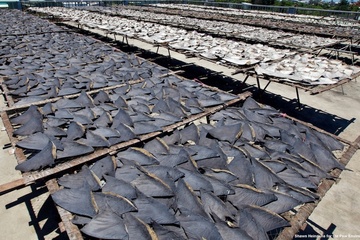Difference between revisions of "Shark fins"
m |
|||
| Line 12: | Line 12: | ||
Well-known species such as the great white shark, tiger shark, blue shark, mako shark, and the hammerhead shark are apex predators—organisms at the top of their underwater food chain. Their survival is threatened by human-related activities.<br><br> | Well-known species such as the great white shark, tiger shark, blue shark, mako shark, and the hammerhead shark are apex predators—organisms at the top of their underwater food chain. Their survival is threatened by human-related activities.<br><br> | ||
| − | [[FILE: | + | [[FILE:Shark fins.jpg]] |
Revision as of 08:53, 6 August 2014
| Infobox on Shark fins | |
|---|---|
| Example of Shark fins |  |
| Facts | |
| Origin | - |
| Stowage factor (in m3/t) | - |
| Humidity / moisture | - |
| Ventilation | - |
| Risk factors | See text |
Shark fins
Description / Application
Sharks are a group of fish characterized by a cartilaginous skeleton, five to seven gill slits on the sides of the head, and pectoral fins that are not fused to the head. Modern sharks are classified within the clade Selachimorpha (or Selachii), and are the sister group to the rays. However, the term "shark" has also been used for extinct members of the subclass Elasmobranchii outside the Selachimorpha, such as Cladoselache and Xenacanthus. Under this broader definition, the earliest known sharks date from more than 420 million years ago.
Since, sharks have diversified into over 470 species. They range in size from the small dwarf lanternshark (Etmopterus perryi), a deep sea species of only 17 centimetres in length, to the whale shark (Rhincodon typus), the largest fish in the world, which reaches approximately 12 metres. Sharks are found in all seas and are common to depths of 2,000 metres. They generally do not live in freshwater although there are a few known exceptions, such as the bull shark and the river shark, which can survive in both seawater and freshwater. They breathe through five to seven gill slits. Sharks have a covering of dermal denticles that protects their skin from damage and parasites in addition to improving their fluid dynamics. They have several sets of replaceable teeth.
Well-known species such as the great white shark, tiger shark, blue shark, mako shark, and the hammerhead shark are apex predators—organisms at the top of their underwater food chain. Their survival is threatened by human-related activities.












